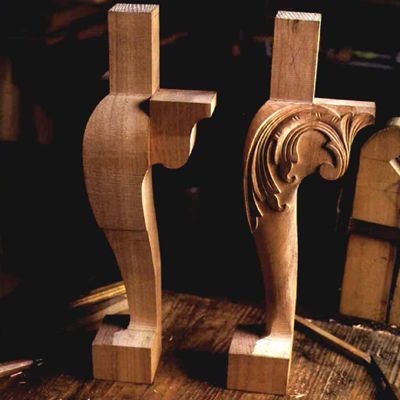
Synopsis: Colonial Williamsburg cabinetmaker Mack Headley explains how to make a leaf pattern on a cabriole leg adapted from one found on a chair from the 1740s. It’s a strong, uncomplicated design with bold reflective surfaces and flowing lines. He breaks the carving process into five steps: cut a full-leg template and mark out a design. Transfer another template to the leg. Cut vertical stop cuts on the leg around the perimeter of the design and carve out the background areas, incise the main shapes of the leaves, and add the veining and other detailing. Headley explains each step and tells you which tools help simplify the labor involved.
The leaf pattern on the cabriole leg shown here is an adaptation of one found on a chair from the 1740s. At that time in the United States, as well as in England, there was general agreement about what constituted good furniture design. And in the 18th century, good design was almost always based on the styles and forms of classical antiquity. But even within the confines of these traditions, an individual carver could elaborate or simplify the specific details, depending on his own notion of the kind of carving that was appropriate for a certain piece.
Today it’s not easy for us to fully understand the depth of classical education and taste in the 18th century, and it’s difficult for us to embrace the sensibility of the cabinetmakers (and their clients) of that time. Yet the surviving works of the period, as seen in museums and in the excellent books depicting such collections, can serve as a pattern book for any carver. Even if you don’t want to duplicate the 18th-century work, these collections offer a repository of design styles. And, a close study of these works gives us a glimpse of the techniques used by these early carvers, who had to meet demanding standards, yet still work efficiently enough to make a living. For example, the shapes and sizes of the tools available to the carver played a large role in determining the design and the speed with which the piece could be carved.
The original of the carving that I will discuss here is an example of a strong, uncomplicated design, with the bold reflective surfaces and flowing lines that would have been expected on carved leafage. Its carver was an economical and experienced workman with high standards, who knew how to maximize the carving’s three-dimensional look despite the limitation of having to work with relatively shallow cuts on the shaped surfaces.
Before going on to the details of foliage work, it’s worth noting that a knee carving such as the one shown in figure 1 need not be restricted to chairs: It would work well on a tea table and could be adapted to the long, curved knees of a tripod table. In all these cases, the majority of the curves in the leg flow along the level of the carving’s background. Thus all curves appear to be continuous beneath the foliage, and the widest part of the knee below the carving is thinner than it would be on an uncarved leg. There is plenty of bulk in this area to ensure a strong leg, however, and the curve can be gently shaped to blend into an ankle about the same thickness as the ankle on an uncarved leg.
From Fine Woodworking #72
For the full article, download the PDF below:
Fine Woodworking Recommended Products

Stanley Powerlock 16-ft. tape measure

Starrett 12-in. combination square

Marking knife: Hock Double-Bevel Violin Knife, 3/4 in.






















Log in or create an account to post a comment.
Sign up Log in